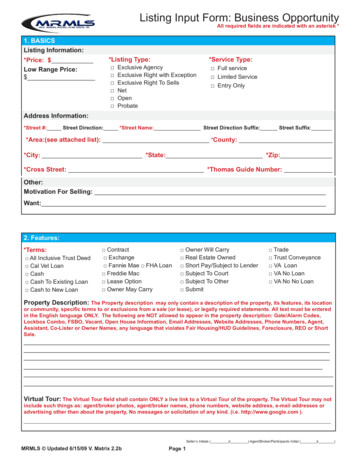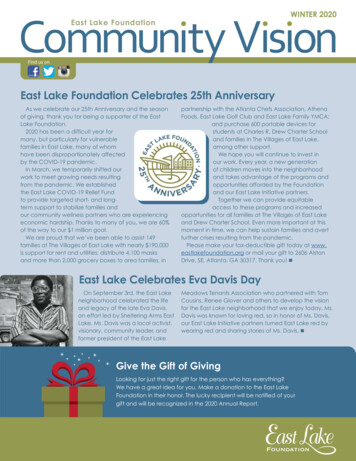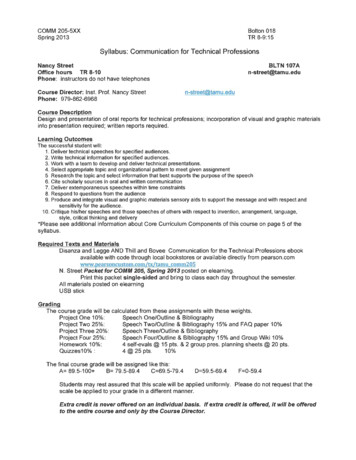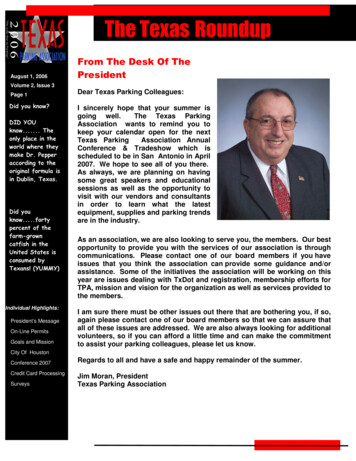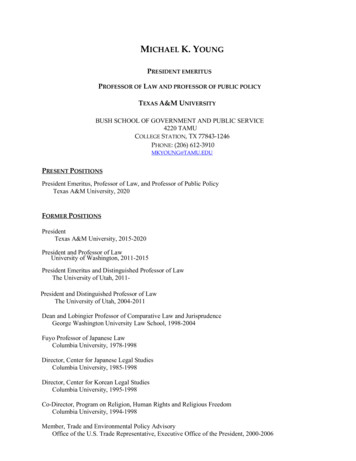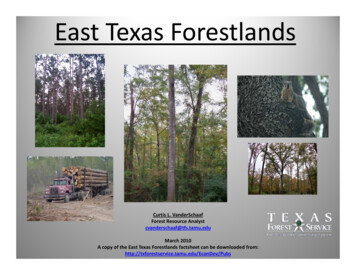
Transcription
East Texas ForestlandsCurtis L. VanderSchaafForest Resource Analystcvanderschaaf@tfs.tamu.eduMarch 2010A copy of the East Texas Forestlands factsheet can be downloaded from:http://txforestservice.tamu.edu/EconDev/Pubs
East Texas ForestlandsSeveral sources of data were used to producethe East Texas Forestlands factsheet and slidepresentation:FIA – Forest Inventory andd AnalysislNWOS – National Woodland Owner SurveyHarvest TrendsTimber Price Trends
East Texas ForestlandsForest Inventory and AnalysisThe FIA is a national program designed to quantify the amount of resources in forestlands.Texas Forest Service in conjunctionjwith the USDA Forest Service annuallyy measures 20% of all plotspestablishedin East Texas.Variables include total height, diameter, volume, biomass, etc.All FIA plots in East Texas are measured over a 5‐year period.
East Texas ForestlandsNWOS Harvest Trends,NWOS,Trends and Texas Timber Price TrendsNational Woodland Owner Survey – NWOS assesses forestland ownercharacteristics. Data were obtained from questionnaires sent out from2002 to 2006 to an area weighted sample of 857 East Texas family forestland owners. There was a 45 percent return rate.Harvest Trends ‐ Texas Forest Service conducts an annual assessment of theamount of primary wood products produced in the state and the amountof stumpage purchased by county and exported to other states to produceprimary wood products.produces a bi‐monthlyyTexas Timber Price Trends – Texas Forest Service ppublication reporting average prices paid for standing timber, commonlycalled stumpage price.
East Texas ForestlandsForestland versus TimberlandForestland – land that is at least 10 percent stocked by forest trees of any size orthath hash beenbat leastl10% stockedk d ini theh past, andd not currentlyl developedd ld forf anonforest useTimberland – forestland that is producing or capable of producing in excess of 20cubic feet per acre per yearAll timberland is forestland.Examples of forestland that WOULD NOT BE classified as timberland are an extremely dry sandy, lowfertility site or a marshland which produce less than 20 cubic feet/acre/yr of woody volume growth.Failing to be classified as timberland does not relate to current stocking but rather potential stockingand site productivity.
ForestlandAcresPercent forestland bycounty, 2008Almost all forestland is timberland(99 percent).t)Nearly 39 percent of the region’sTimberland is located in just 10 ofthe 43 counties.12Miillion acresForestland makes up about 54 percentof the East Texas region.Area of timberland, 1992‐200811.51110.510199220032008YearArea of timberland, 2008There were 11,964, 913 acres oftimberland estimated in 2008.Longleaf‐slash pine 2%Eastern redcedar 1%Other 3%Oak‐pineOakpine13%Southern pine forests consist primarily of loblolly pine – about half plantedand half occurring naturally.Loblolly‐shortleaf pine41%Lowlandhardwoods17%Lowland hardwoods consist of the oak‐gum‐cypress and elm‐ash‐cottonwoodforest types.Oak‐hickory24%
ForestlandAcresAcres of timberland planted by species,species 2008Area of timberland by forest type and county, 2008PinePlanted Pine(Other includes bald cypress, cherrybark oak, longleaf pine, Scotchpine and Virginia pine)Oak‐PineRegion 25002500 to 50005000 to 1000010000 to 2000020000 to 35000SpeciesLoblolly pineSE Texas OtherSlash pineAcres1,883,07417,160104,097Loblolly pineNE Texas OtherSlash pine882,61618,2569,34435000 to 5000050000 to 100000100000 to 150000150000 to cottonwoodArea of timberland across all forest types bycounty, 2008200000 to 250000 250000 30000TimberlandNE Texas30000 to 100000100000 to 150000150000 tot 200000200000 to 250000250000 to 300000300000 to 350000350000 to 400000400000 tot 450000450000 to 525000 525000SE Texas
ForestlandOwnershipPercent forestland by county, 2008Other public 3%Private owners, consisting of Timber Investment Management Organizations(TIMOs) and Real Estate Investment Trusts (REITs) as well as family forestowners,, control 92 ppercent of the timberland.National Forest 5%Questionnaires were sent out from 2002 to 2006 in an area weighted sampleof 857 family forest owners. There was a 45 percent return rate.According to survey resultsresults, timber was harvested on 74 percent ofthe family forest acreage.Private 92%The vast majority of owners possessed small tracts of land while just afew people held large tracts.Response by family forest owner (formerly Non‐Industrial Private Forest, or NIPF), 2006Size of forestTimber activityTimber harvestYesNoNo answerHarvested past 5 yearsAreamillion acrespercent4.81.50.12.37424236Acres1‐910‐1920 4920‐4950‐99100‐1000 1000Areathousand housand percentNumber944555263115178115 1‐
ForestlandStand‐product class by surveyyear, timberland, 1992 to 2008Stand Structure719922003Stand‐product class is the same as stand‐size class.2008Million accres65Sawtimber sized stands constitute 52 ppercent of the region.g43Poletimber sized stands constitute 22 percent.21Sapling‐seedling sized stands make up the remaining 26 dlNonstockedkdYearStand‐diameter by stand‐product class, 4.3Stand‐diameter class (inches d.b.h.)0 to5 to9 to20 to 5 9 20 40thousand acres122.8 876.3 4822.5103.5 2077.7 433.31933.0 807.0 213.652.417.19.12211.6 3778.1 5478.4341.916.322.71.5382.4Sawtimber. As defined by FIA, softwood species 9.0 inches d.b.h and larger and hardwoods 11.0 inches d.b.h. and largerPoletimber. As defined by FIA, softwood species 5.0 to 8.9 inches d.b.h. and hardwoods 5.0 to 10.9 inches d.b.h.Saplings. As defined by FIA, Live trees 1.0 to 4.9 inches d.b.h.Seedlings. As defined by FIA, live trees 1.0 inch d.b.h. and 1 foot tall for hardwoods, 6 inches tall for softwoods
Trees Per AcrePinePlanted PineOak‐PineNone recorded0 to 200200 to 400400 to 600600 to 800800 to 10001000 to 1200Oak‐hickory1200 to 14001400 to 16001600 to 18001800 to 20002000 to 2200Across all forest types,types there was an average of 638 trees per acre.acreOak ‐gum‐cypressElm‐ash‐cottonwood
VolumeStand StructureVolume in live trees by dbh,timberland 1992 to 2008timberland,SoftwoodsBillion cubbic feet1.419922003Softwood volume is 9.5 billion cubic feet for live trees.20081.21Hardwood volume is 7.87 8 billion cubic feet for live trees.trees080.80.60.40.20681012141618202529 2529 Diameter class (inches)Hardwoods1.2Billioon cubic eter class (inches)
VolumeAmountGrowing stock volume of plantationtimberland by species, 2008SpeciesL bl ll pineLoblollyiSE Texas OtherSlash pineft31 642 423 8181,642,423,8187,602,450148,559,642Loblolly pineNE Texas OtherSlash pine812,981,14223 063 62123,063,62110,254,287RegionGrowing stock volume (ft3) on timberlandby forest type and county, 2008PinePlanted PineOak ne recorded0 to 75,000,00075 000 000 to 150,000,00075,000,000150 000 000Oak‐hickory150,000,000 to 225,000,000225,000,000 to 300,000,000300,000,000 to 375,000,000375,000,000 to 450,000,000450,000,000 to 525,000,000525,000,000 to 600,000,000600,000,000 to 675,000,000Pine is more heavily concentrated in the southern region whileoak‐hickory is more plentiful in the northern region.Growing‐stock trees. Live trees that contain at least one 12‐foot or two 8‐foot logs in the saw‐log portion, either currently or potentially, if too small to qualify as a sawlog. The log(s) must meetdimension and merchantability standards to qualify. Trees must have one‐third of the gross board‐foot volume in sound wood, either currently or potentially.
VolumeChangegGrowth to removals ratio and average annual livetree (growing stock in parentheses) growth,removals and mortality for timberlandremovals,timberland,2003 to 2008ItemNet growth‐to‐removalsratioSoftwoodsHardwoods1.17 (1.17)1.62 (1.69)million ftComponent of changeGross growthMortalityNet growthRemovals742.5 (729.4)74.9 (72.1)667.5 (657.3)568.8 (560.2)3381.7 (325.3)74.8 (53.3)306.9 (272.0)189.5 (161.1)Components of change between2003 and 2008ItemSample estimateLand area (1,000 acres)Forestland12128.7Timberland11964.9Reserved forestland126.7Other forestland37.13All live on timberland (million ft )InventoryNet annual growthAnnual mortality*Annual removals17292.3317292974.4149.7758.33Growing stock on timberland (million ft )InventoryNet annual growthAnnual mortality*Annual removals15982.9929.3125.3721.3Sawtimber on timberland (million fbm )InventoryNet annual growthAnnual mortality*Annual removals62897.53517.8536.62616.0* Net annual growth includes annual mortality.The positive net growth‐to‐removals ratios indicate growth exceededremovals.For private lands, the ratio across all species was 1.33 for all trees and1.31 for growing stock trees.
BiomassStanding Biomass (oven‐dry tons) – Aboveground Wood and BarkSoftwood biomass is 206.1 million oven‐dry tons for live trees (dbh of 1.0inch or greater).Hardwood biomass is 238.7238 7 million ovenoven‐drydry tons for live trees.treesStanding biomass (oven‐dry tons) of all trees on forestland byforest type and county, 2008PiPinePl t d PinePlantedPiO k PiOak‐PineBiomass of all trees (oven‐dry tons) onplantation forestland by species, 2008RegionSpeciesOven‐dry tonsLoblolly pine46,488,146SE Texas Other221,687Slash pine4,464,736Loblolly pineNE Texas OtherSlash pine22,924,925539,690278,597Standing biomass (oven‐dry tons) of all trees onforestland by county, 2008None recorded0 to 500,000500 000NE Texas500,000 to 1,000,0001,000,000 to 3,000,0001,000,000 to 4,000,0003,000,000 to 5,000,0004,000,000 to 7,000,0005,000,000 to 7,000,000O k hi kOak‐hickory7,000,000 to 9,000,0000O kOak‐gum‐cypressElElm‐ash‐cottonwoodh ttd7,000,000 to 10,000,0009,000,000 to 11,000,000010,000,000 to 13,000,00011,000,000 to 13,000,00013,000,000 to 16,000,00013,000,000 to 15,000,00016,000,000 to 19,000,00019,000,000 to 22,000,000SE Texas
BiomassAverage Standing Biomass Per AcreAverage standing biomass (oven‐dry tons) per acre of alltrees on forestland by county, 2008PinePlanted PineOak‐PineNone recorded0 to 1010 to 2020 to 3030 to 4040 to 5050 to 6060 to 7070 to 8080 to 9090 to 100100 to 110Oak hickoryOak‐hickoryOak gum cypressOak‐gum‐cypressElm ash cottonwoodElm‐ash‐cottonwood
Logging ResidueHarvesting operations produce logging residue – or biomass – thatcan potentially be used to produce bioenergy and biofuel.An estimated 2.3 million green tons of logging residue (including tops,limbs, and unutilized cull trees but excluding stumps) was generatedduring 2008 harvests.Due to logisticslogistics, harvesting techniques,techniques and economics,economics not alllogging residue will be available for bioenergy/biofuel production – somebelieve only 30 to 60% of residues will be utilizable.Logging residue (green tons per acre), 20080 to 20,00020,000 to 40,00040 000 to 60,00040,00060 00060,000 to 80,00080,000 to 100,000100,000 to 120,000120,000 to 140,000140,000 to 160,000160,000 to 180,000180,000 to 200,000
Acres Planted by YearBoth the number of family forest (formerlynon‐industrial private forest landowners)and the total number (also includes privatecompanies and public agencies) of acresplanted have declined over the pastdecade.‘Year’ refers to fiscal year. For example,fiscal year 2006 began on Oct 1, 2005 andendedd d Sept. 30, 2006.All species are included.Number of amily forest48,35843,181,48,43833,16426,35836,89633 75114,39290,193113,686103 601103,60192,030105,93686,546
Major Mill Shutdowns/ClosuresCompany NameMill LocationAbitibi‐Consolidated Inc.Lufkin, TXClemsa Lumber Co.Pollok, TXGeorgia‐PacificLogansport, LAGeorgia‐PacificSpringhill, LAInternational Paper Co.Bastrop, LALouisiana‐Pacific Corp.Silsbee, TXNorbord Inc.Jefferson, TXNorth American Procurement Co.Moscow, TXPasadena Paper Co.Pasadena, TXPotlatch Corp.Prescott, ARTemple‐InlandPineland, TXWeyerhaeuserMountain Pine, ARSeveral large‐scale mills in East Texas and surrounding states have haltedoperations, some permanently while others indefinitely, resulting in animpact on the long term timber supply.Mill TypePaper millLumber millPlywoodPlywoodPaper millOriented Strand Board (OSB)Oriented Strand Board (OSB)Chip millPaper millLumber millSoftwood VeneerPlywood
40NE TexasSE TexasSoftwood chip‐n‐saw255010500162014151035SE Texas15NE Texas4SE Texas2Hardwood sawtimberNE Texas1210208104520001999 Jan/Feb1999 Mar/Apr1999 May/Jun1999 Jul/Aug1999 Sep/Oct1999 Nov/Dec2000 Jan/Feb2000 Mar/Apr2000 May/Jun2000 Jul/Aug2000 Sep/Oct2000 Nov/Dec2001 Jan/Feb2001 Mar/Apr2001 May/Jun2001 Jul/Aug2001 Sep/Oct2001 Nov/Dec2002 Jan/Feb2002 Mar/Apr2002 May/Jun2002 Jul/Aug2002 Sep/Oct2002 Nov/Dec2003 Jan/Feb2003 Mar/Apr2003 May/Jun2003 Jul/Aug2003 Sep/Oct2003 Nov/Dec2004 Jan/Feb2004 Mar/Apr2004 May/Jun2004 Jul/Aug2004 Sep/Oct2004 Nov/Dec2005 Jan/Feb2005 Mar/Apr2005 May/Jun2005 Jul/Aug2005 Sep/Oct2005 Nov/Dec2006 Jan/Feb2006 Mar/Apr2006 May/Jun2006 Jul/Aug2006 Sep/Oct2006 Nov/Dec2007 Jan/Feb2007 Mar/Apr2007 May/Jun2007 Jul/Aug2007 Sep/Oct2007 Nov/Dec2008 Jan/Feb2008 Mar/Apr2008 May/Jun2008 Jul/Aug2008 Sep/Oct2008 Nov/Dec2009 Jan/Feb3060 /toon701999 Jan/Feb1999 Mar/Apr1999 May/Jun1999 Jul/Aug1999 Sep/Oct1999 Nov/Dec2000 Jan/Feb2000 Mar/Apr2000 May/Jun2000 Jul/Aug2000 Sep/Oct2000 Nov/Dec2001 Jan/Feb2001 Mar/Apr2001 May/Jun2001 Jul/Aug2001 Sep/Oct2001 Nov/Dec2002 Jan/Feb2002 Mar/Apr2002 May/Jun2002 Jul/Aug2002 Sep/Oct2002 Nov/Dec2003 Jan/Feb2003 Mar/Apr2003 May/Jun2003 Jul/Aug2003 Sep/Oct2003 Nov/Dec2004 Jan/Feb2004 Mar/Apr2004 May/Jun2004 Jul/Aug2004 Sep/Oct2004 Nov/Dec2005 Jan/Feb2005 Mar/Apr2005 May/Jun2005 Jul/Aug2005 Sep/Oct2005 Nov/Dec2006 Jan/Feb2006 Mar/Apr2006 May/Jun2006 Jul/Aug2006 Sep/Oct2006 Nov/Dec2007 Jan/Feb2007 Mar/Apr2007 May/Jun2007 Jul/Aug2007 Sep/Oct2007 Nov/Dec2008 Jan/Feb2008 Mar/Apr2008 May/Jun2008 Jul/Aug2008 Sep/Oct2008 Nov/Dec2009 Jan/Feb30 /toonSoftwood sawtimber1999 Jan/Feb1999 Mar/Apr1999 May/Jun1999 Jul/Aug1999 Sep/Oct1999 Nov/Dec2000 Jan/Feb2000 Mar/Apr2000 May/Jun2000 Jul/Aug2000 Sep/Oct2000 Nov/Dec2001 Jan/Feb2001 Mar/Apr2001 May/Jun2001 Jul/Aug2001 Sep/Oct2001 Nov/Dec2002 Jan/Feb2002 Mar/Apr2002 May/Jun2002 Jul/Aug2002 Sep/Oct2002 Nov/Dec2003 Jan/Feb2003 Mar/Apr2003 May/Jun2003 Jul/Aug2003 Sep/Oct2003 Nov/Dec2004 Jan/Feb2004 Mar/Apr2004 May/Jun2004 Jul/Aug2004 Sep/Oct2004 Nov/Dec2005 Jan/Feb2005 Mar/Apr2005 May/Jun2005 Jul/Aug2005 Sep/Oct2005 Nov/Dec2006 Jan/Feb2006 Mar/Apr2006 May/Jun2006 Jul/Aug2006 Sep/Oct2006 Nov/Dec2007 Jan/Feb2007 Mar/Apr2007 May/Jun2007 Jul/Aug2007 Sep/Oct2007 Nov/Dec2008 Jan/Feb2008 Mar/Apr2008 May/Jun2008 Jul/Aug2008 Sep/Oct2008 Nov/Dec2009 Jan/Feb25 //ton301999 Jan/Feb1999 Mar/Apr1999 May/Jun1999 Jul/Aug1999 Sep/Oct1999 Nov/Dec2000 Jan/Feb2000 Mar/Apr2000 May/Jun2000 Jul/Aug2000 Sep/Oct2000 Nov/Dec2001 Jan/Feb2001 Mar/Apr2001 May/Jun2001 Jul/Aug2001 Sep/Oct2001 Nov/Dec2002 Jan/Feb2002 Mar/Apr2002 May/Jun2002 Jul/Aug2002 Sep/Oct2002 Nov/Dec2003 Jan/Feb2003 Mar/Apr2003 May/Jun2003 Jul/Aug2003 Sep/Oct2003 Nov/Dec2004 Jan/Feb2004 Mar/Apr2004 May/Jun2004 Jul/Aug2004 Sep/Oct2004 Nov/Dec2005 Jan/Feb2005 Mar/Apr2005 May/Jun2005 Jul/Aug2005 Sep/Oct2005 Nov/Dec2006 Jan/Feb2006 Mar/Apr2006 May/Jun2006 Jul/Aug2006 Sep/Oct2006 Nov/Dec2007 Jan/Feb2007 Mar/Apr2007 May/Jun2007 Jul/Aug2007 Sep/Oct2007 Nov/Dec2008 Jan/Feb2008 Mar/Apr2008 May/Jun2008 Jul/Aug2008 Sep/Oct2008 Nov/Dec2009 Jan/Feb //ton201999 Jan/Feb1999 Mar/Apr1999 May/Jun1999 Jul/Aug1999 Sep/Oct1999 Nov/Dec2000 Jan/Feb2000 Mar/Apr2000 May/Jun2000 Jul/Aug2000 Sep/Oct2000 Nov/Dec2001 Jan/Feb2001 Mar/Apr2001 May/Jun2001 Jul/Aug2001 Sep/Oct2001 Nov/Dec2002 Jan/Feb2002 Mar/Apr2002 May/Jun2002 Jul/Aug2002 Sep/Oct2002 Nov/Dec2003 Jan/Feb2003 Mar/Apr2003 May/Jun2003 Jul/Aug2003 Sep/Oct2003 Nov/Dec2004 Jan/Feb2004 Mar/Apr2004 May/Jun2004 Jul/Aug2004 Sep/Oct2004 Nov/Dec2005 Jan/Feb2005 Mar/Apr2005 May/Jun2005 Jul/Aug2005 Sep/Oct2005 Nov/Dec2006 Jan/Feb2006 Mar/Apr2006 May/Jun2006 Jul/Aug2006 Sep/Oct2006 Nov/Dec2007 Jan/Feb2007 Mar/Apr2007 May/Jun2007 Jul/Aug2007 Sep/Oct2007 Nov/Dec2008 Jan/Feb2008 Mar/Apr2008 May/Jun2008 Jul/Aug2008 Sep/Oct2008 Nov/Dec2009 Jan/Feb /toonTimber Stumpage Price TrendsCurrent softwood sawtimber stumpage prices are at their lowest since the late 1990s.1990sHardwood sawtimber has also dropped after peaking in 2007‐2008.Hardwood and softwood pulpwood prices also dropped since peaking in 2007‐2008.Chip‐n‐saw prices gradually dropped following a peak period from 2004 to 2007.Prices below are from Jan/Feb 1999 to Jan/Feb 2009.Softwood pulpwood18NE Texas12SE Texas108614Hardwood pulpwoodNE TexasSE Texas6
Definition of TermsComponent of change. References the change in the volume oftrees averaged over the years of the intersurvey period, specifically:Average annual gross growth. Change in the volume of trees inthe absence of cutting and mortalityAverage annuall mortality.Ali VolumeV loff trees thath dieddi d fromfnatural causesAverage net annual growth. Net change in volume in the absenceof removals, and calculated as average annual gross growthminus average annual mortalityAverage annual removal. Volume of trees removed from theinventory by harvesting, cultural operations, (e.g., timber‐standimprovement), land clearing, or change in land use and averagedover the years of the intersurvey periodD.b.h. Tree stem diameter in inches measured outside the barkand 4.5 feet above the ground (breast height)Family forest. Private land owned by individuals andffamilies,ili includingi l di ffarms, wherehtheth owner doesdnott owna primary wood‐using plant or is not a formally incorporatedcompany or organization. Formally referred to as non‐industrialprivate forest (NIPF) owners.Forestland. Land at least 10% stocked by forest trees of any size orthat has been at least 10% stocked in the past, and not currentlydeveloped for nonforest use. The minimum dimensions are 1 acre insize and 120 feet in width.Timberland. Forestland capable of producing 20 cubic feet ofwoodd volumelper acre annuallyll andd not withdrawni hdfromftimberi butilizationReserved forestland. Public forestland capable of producing20 cubic feet of wood volume per acre annually, butwithdrawn from timber utilization through statute oradministrative regulationOther forestland. Forestland that is incapable of producing20 cubic feet of wood volume per acre annually undernatural conditions due to adverse site conditions such assterile soils, dry climate, poor drainage, high elevation,steepness, or rockiness. The term is synonymous withwoodland in earlier FIA reports.Forest type. Forestland classification of the species forming apluralityl lit off liveli treetstocking,t ki andd largelyll basedb d on an algorithml ith offtallied treesGrowing‐stock trees. Live trees that contain at least one 12‐foot or two 8‐foot logs in the saw‐log portion, either currently orpotentially, if too small to qualify as a sawlog. The log(s) must meetdimension and merchantability standards to qualify. Trees must haveone‐third of the gross board‐foot volume in sound wood, eithercurrently or potentially.
Definition of TermsGrowth‐to‐removals ratio. The ratio of net growth in volumedivided by the volume removed by human activity, includingharvesting, land clearing, and changes in land usePoletimber. As defined by FIA, softwood species 5.0 to 8.9 inchesd.b.h. and hardwoods 5.0 to 10.9 inches d.b.h.Saplings. As defined by FIA, Live trees 1.0 to 4.9 inches d.b.h.Hardwoods. Dicotyledonous trees, usually broadleaf and deciduous.LLoggingi residue.idW d materialWoodyi l thath isi not removedd fromfsitesiduring harvesting operations. Types of logging residue includestumps, tops, limbs and unutilized cull trees.Stump residue is the part of the tree that is lower than the cuttingpoint and thus left after the harvesting operation, is generally notavailable commercially since the cost of obtaining the stump orroot biomass is likely prohibitive.Tops refer to the tops of the trees that are either broken duringharvesting or are cut off the central stem of the tree due to amerchantability standard.Limbs refer to the branches of the trees.Cull trees are the trees that cannot be used to produce saw logsdue to defects, rot, or form. Some cull trees are used as pulpwoodand others are left unutilized as a part of logging residue.Tops, limbs, and unutilized cull trees are the logging residue that ispotentiallyt ti ll availableil bl as bibiomass forf energy productiond ti or chemicalh i lextraction.Sawtimber. As defined by FIA, softwood species 9.0 inches d.b.h andllargerandd hardwoodsh dd 11.011 0 inchesi h d.b.h.d b h andd largerlSeedlings. As defined by FIA, live trees 1.0 inch d.b.h. and 1 foot tall for hardwoods, 6 inches tall for softwoodsSoftwoods. Coniferous trees,Softwoodstrees usually evergreen,evergreen havingneedles or scale‐like leavesStumpage. Standing trees in the forestVolume. The amount of sound wood in live trees at least 5.0 inchesd.b.h. from a 1‐foot stump to a minimum 4.0‐inch top diameteroutside bark of the central stem
FIA - Forest Inventory and Analysis NWOS -National Woodland Owner Survey Harvest Trends Timber Price Trends. East Texas Forestlands Forest Inventory and Analysis The FIA is a national program designed to quantify the amount of resources in forestlands. . 1992 2003 2008 Softwood volume is 9.5 billion cubic feet for live trees.

